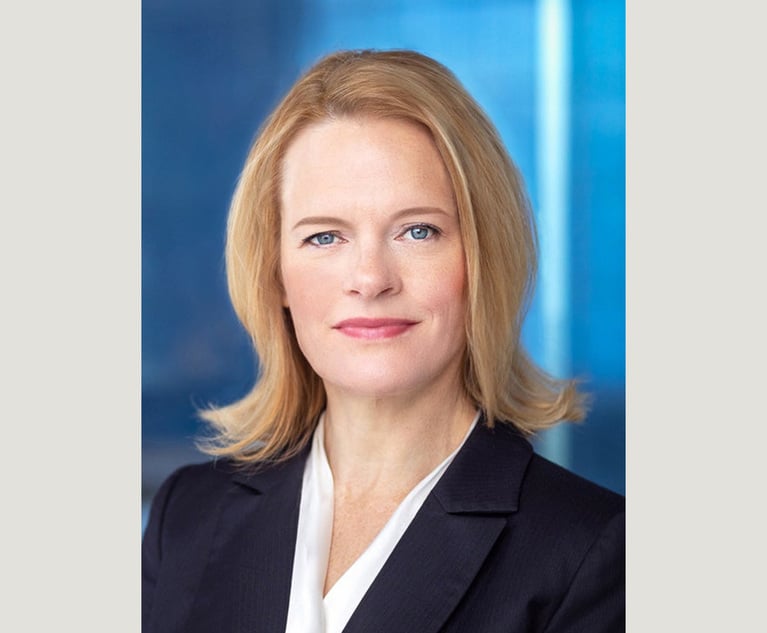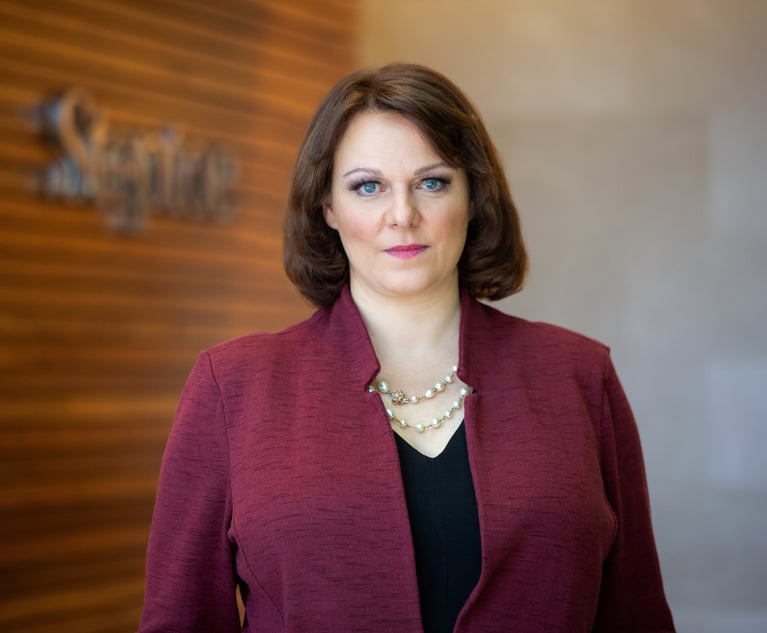Of Course! SCOTUS Appears Split Over How to Handle Split Decisions
Some justices seemed sympathetic to the problems caused by splintered opinions for lower court judges especially when, as Chief Justice John Roberts Jr. put it, “If I'm a court of appeals judge, it seems to me the most important thing in deciding the case is to make sure that I'm not reversed.”
March 27, 2018 at 04:25 PM
4 minute read

It is rare, bordering on never, for the U.S. Supreme Court to discuss during an oral argument how it makes its decisions and how they should be interpreted.
But an hourlong argument on Tuesday was all about that. The nine justices debated about what should happen when they issue fragmented decisions, like those that are split 4-1-4.
For 41 years, the court's ruling in Marks v. United States provided the answer: “When a fragmented court decides a case and no single rationale explaining the result enjoys the assent of five justices, the holding of the court may be viewed as that position taken by those members who concurred in the judgments on the narrowest grounds.”
The classic 4-1-4 case was Regents of the University of California v. Bakke, the 1978 affirmative action ruling in which the late Justice Lewis Powell Jr.'s solitary and narrow opinion became the prevailing decision.
In Tuesday's case, Hughes v. United States, the dispute was over the meaning of Freeman v. United States, a 2011 sentencing decision, where lower courts are split over whether Justice Sonia Sotomayor's solo concurrence should be the controlling opinion.
The quandary provoked fanciful hypotheticals, which lawyers for both sides deftly handled. Eric Shumsky, partner at Orrick, Herrington & Sutcliffe, represented the defendant and urged the court to reconsider the Marks rule. Rachel Kovner, assistant to the U.S. solicitor general, argued for the status quo.
“Let's say that nine people are deciding which movie to go and see,” Justice Samuel Alito Jr. posited, “and four of them want to see a romantic comedy, and two of them want to see a romantic comedy in French, and four of them want to see a mystery. Are the two who want to see the romantic comedy in French, is that a logical subset of those who want to see a romantic comedy?”
Shumsky's answer was to urge all the players to make their preferences clear. “Anytime, two people, be they justices of this court or people going to see a romantic comedy, can say here's how far I go, but I don't agree with that thing over there,” he said.
In a more serious vein, some justices seemed sympathetic to the problems caused by splintered opinions for lower court judges especially when, as Chief Justice John Roberts Jr. put it, “If I'm a court of appeals judge, it seems to me the most important thing in deciding the case is to make sure that I'm not reversed.”
 Justice Elena Kagan (2015). Credit: Diego M. Radzinschi / ALM
Justice Elena Kagan (2015). Credit: Diego M. Radzinschi / ALM Justice Elena Kagan worried aloud, “There are some cases where there are middle-ground positions which seem utterly incoherent to anybody else, incoherent or maybe it's based on what you think is an impermissible criterion, or for some reason the middle ground is the worst of all possible worlds.”
She also expressed concern about the situation where a solo concurrence agrees with the plurality on some issues and the dissent on others. “By privileging the concurrence, you're essentially saying that when the concurrence agrees with the dissent, the concurrence wins, which I take it is because the concurrence plus the dissent equals five,” she said.
Justice Stephen Breyer seemed to want to stick with the Marks rule and just hope that lower courts will use common sense in interpreting the court's decisions.
Citing the 1978 Bakke ruling, Breyer said, “Powell, of course, is in part key because he had a sensible view. And the public, the lawyers, the clients, the other judges, are the ones who tell us that over time. … They've done all right with Marks. Leave it alone.”
Alito was also dubious about change. “If we abandon [Marks] completely, it could have pretty profound changes. Why should we do that?”
Read more:
Plurality Puzzles | Microsoft & the CLOUD | Relishing RBG
Thomas Calls 2nd Amendment a 'Constitutional Orphan.' Stevens Now Says Repeal It
How Merrick Garland Landed a Supreme Court Clerkship With Brennan
Trump's Newest Tweet Target: Solicitor General Noel Francisco
Kagan Recalls Her 'Knucklehead' Days Clerking for Thurgood Marshall
This content has been archived. It is available through our partners, LexisNexis® and Bloomberg Law.
To view this content, please continue to their sites.
Not a Lexis Subscriber?
Subscribe Now
Not a Bloomberg Law Subscriber?
Subscribe Now
NOT FOR REPRINT
© 2025 ALM Global, LLC, All Rights Reserved. Request academic re-use from www.copyright.com. All other uses, submit a request to [email protected]. For more information visit Asset & Logo Licensing.
You Might Like
View All

SEC Official Hints at More Restraint With Industry Bars, Less With Wells Meetings
4 minute read

Sidley Adds Ex-DOJ Criminal Division Deputy Leader, Paul Hastings Adds REIT Partner, in Latest DC Hiring
3 minute readTrending Stories
- 1Decision of the Day: Court Holds Accident with Post Driver Was 'Bizarre Occurrence,' Dismisses Action Brought Under Labor Law §240
- 2Judge Recommends Disbarment for Attorney Who Plotted to Hack Judge's Email, Phone
- 3Two Wilkinson Stekloff Associates Among Victims of DC Plane Crash
- 4Two More Victims Alleged in New Sean Combs Sex Trafficking Indictment
- 5Jackson Lewis Leaders Discuss Firm's Innovation Efforts, From Prompt-a-Thons to Gen AI Pilots
Who Got The Work
J. Brugh Lower of Gibbons has entered an appearance for industrial equipment supplier Devco Corporation in a pending trademark infringement lawsuit. The suit, accusing the defendant of selling knock-off Graco products, was filed Dec. 18 in New Jersey District Court by Rivkin Radler on behalf of Graco Inc. and Graco Minnesota. The case, assigned to U.S. District Judge Zahid N. Quraishi, is 3:24-cv-11294, Graco Inc. et al v. Devco Corporation.
Who Got The Work
Rebecca Maller-Stein and Kent A. Yalowitz of Arnold & Porter Kaye Scholer have entered their appearances for Hanaco Venture Capital and its executives, Lior Prosor and David Frankel, in a pending securities lawsuit. The action, filed on Dec. 24 in New York Southern District Court by Zell, Aron & Co. on behalf of Goldeneye Advisors, accuses the defendants of negligently and fraudulently managing the plaintiff's $1 million investment. The case, assigned to U.S. District Judge Vernon S. Broderick, is 1:24-cv-09918, Goldeneye Advisors, LLC v. Hanaco Venture Capital, Ltd. et al.
Who Got The Work
Attorneys from A&O Shearman has stepped in as defense counsel for Toronto-Dominion Bank and other defendants in a pending securities class action. The suit, filed Dec. 11 in New York Southern District Court by Bleichmar Fonti & Auld, accuses the defendants of concealing the bank's 'pervasive' deficiencies in regards to its compliance with the Bank Secrecy Act and the quality of its anti-money laundering controls. The case, assigned to U.S. District Judge Arun Subramanian, is 1:24-cv-09445, Gonzalez v. The Toronto-Dominion Bank et al.
Who Got The Work
Crown Castle International, a Pennsylvania company providing shared communications infrastructure, has turned to Luke D. Wolf of Gordon Rees Scully Mansukhani to fend off a pending breach-of-contract lawsuit. The court action, filed Nov. 25 in Michigan Eastern District Court by Hooper Hathaway PC on behalf of The Town Residences LLC, accuses Crown Castle of failing to transfer approximately $30,000 in utility payments from T-Mobile in breach of a roof-top lease and assignment agreement. The case, assigned to U.S. District Judge Susan K. Declercq, is 2:24-cv-13131, The Town Residences LLC v. T-Mobile US, Inc. et al.
Who Got The Work
Wilfred P. Coronato and Daniel M. Schwartz of McCarter & English have stepped in as defense counsel to Electrolux Home Products Inc. in a pending product liability lawsuit. The court action, filed Nov. 26 in New York Eastern District Court by Poulos Lopiccolo PC and Nagel Rice LLP on behalf of David Stern, alleges that the defendant's refrigerators’ drawers and shelving repeatedly break and fall apart within months after purchase. The case, assigned to U.S. District Judge Joan M. Azrack, is 2:24-cv-08204, Stern v. Electrolux Home Products, Inc.
Featured Firms
Law Offices of Gary Martin Hays & Associates, P.C.
(470) 294-1674
Law Offices of Mark E. Salomone
(857) 444-6468
Smith & Hassler
(713) 739-1250








